Using the latest research to suggest effective measures to combat the heat! Aiming to become a bridge between research and practical use
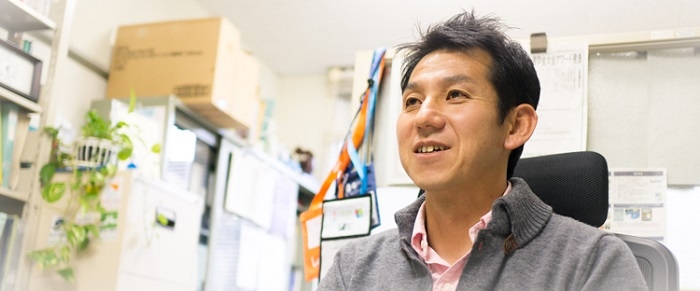
We talked to Associate Professor Hiroshi Hasegawa, Behavioral Sciences Section, Division of Human Sciences, Graduate School of Integrated Arts and Sciences.
(Interview: November 12, 2014 by PR Group)
Introduction
Associate Professor Hasegawa specializes in exercise physiology and environmental physiology. At an academic society meeting in July this year, he received the best oral presentation award for his presentation entitled “The Functional Role of a Cerebral Neurotransmitter (Dopamine) in the Thermoregulation Mechanism during Exercise.”
In addition, Sumire Onitsuka, one of the doctoral candidates whom he supervises (1st year doctoral program, Graduate School of Integrated Arts and Sciences), and Xinyan Zheng, an international student from China (3rd year doctoral program, Graduate School of Integrated Arts and Sciences), have received a number of awards from both domestic and international academic societies. In recognition of these achievements in the field of both research and educational activities, Associate Professor Hasegawa received the Hiroshima University President’s Award in FY2014.
He is also active in a wide range of other activities: in his applied research, he worked with a manufacturer overseas to develop a cooling jacket, thereby contributing to efforts to prevent heat stroke during sporting activities. In addition, he serves as the director and manager of the Hiroshima University Women’s Soccer Club; under his leadership, the team made it to the national tournament for the first time in 13 years.
While conducting a wide range of research, from basic to applied, Associate Professor Hasegawa is also achieving remarkable results in the fields of education and activities that contribute to society. We asked him about his latest research and his hopes for our students.
*Photographs from the 13th (FY2014) Hiroshima University President’s Awards Ceremony can be found here.
Dopamine’s relationship to thermoregulation revealed!
Dopamine is an excitatory neurotransmitter and the quantity released in the brain is known to increase as a result of exercise. Associate Professor Hasegawa has ascertained that dopamine in the brain is related to the thermoregulation mechanism and exercise capacity.
An unfortunate event involving an athlete triggered Associate Professor Hasegawa’s interest in dopamine.
He tells us, “Some years ago, before a race, a foreign athlete ingested a substance that had a stimulant effect on the central nervous system and died during the race. The cause was presumed to be heat stroke, but the mechanism that led to his death was never fully clarified. Accordingly, I conducted animal research using rats to investigate the thermoregulatory response and changes in the brain that occur when engaging in strenuous exercise in a hot environment. As a result of my experiments, I discovered that the quantity of dopamine released in the hypothalamus increases during exercise and that dopamine is related to thermoregulation during exercise.”
It subsequently became clear that if the quantity of dopamine in the brain increases due to a pharmacological stimulus, exercise capacity improves. He also verified these results in exercise tests on humans when he was studying in Belgium on an overseas special research fellowship funded by the Japan Society for the Promotion of Science. However, he points out that even if the amount of dopamine rises, the body still has limits, so if heat or other environmental factors exacerbate the situation, it can, in a worst-case scenario, lead to fatal accidents such as the one involving the aforementioned athlete.
“Talking about it like this makes it sound like dopamine’s a bad substance, but insufficient dopamine is actually thought to cause conditions such as Parkinson’s disease, which causes tremors in the hands and feet. In other words, well-balanced releases of dopamine in the brain are crucial for both thermoregulation and motor function,” he stresses.
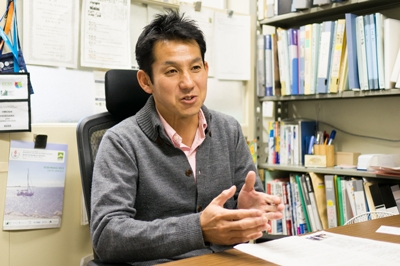
Associate Professor Hasegawa talks about his latest research findings.
Measures to combat heat are the key to victory
In addition to basic research, Associate Professor Hasegawa also devotes his energies to applied research focused on measures to combat heat.
He tells us, “In my basic research, the physiological mechanism that leads to heat stroke is becoming clearer, so I’m also actively working on applied research. It involves thinking about how to achieve the best possible athletic performance, without getting to the heat stroke stage, and then devising suitable measures.”
International contests such as the FIFA World Cup and the Olympics are being held in hot environments these days. The 2020 Tokyo Olympics are due to take place from late July to early August, which is the period with the largest number of cases of heat stroke in Japan.
“I want to devise effective measures to combat heat so that as many athletes as possible can win medals, even in such a harsh environment,” he says with enthusiasm.
Developing items to combat heat
Associate Professor Hasegawa does not only propose measures, but is also involved in practical endeavors, working in partnership with manufacturers to develop items to combat heat. Apparently, he is conducting research into measures to combat heat, working in partnership with an air conditioner manufacturer, as well as with a Japanese sporting equipment manufacturer and a sports drink maker, with the aim of enabling athletes to maintain athletic performance in hot environments.
In particular, his research with the beverage manufacturer involves “identifying when and how sports drinks should be drunk and what quantity should be consumed in order to prevent heat stroke and improve sweat efficiency, as well as maintaining athletic performance.”
“I’m focusing on the temperature of the drink,” he says. “In my lab, some of the graduate students are comparing the effects of drinking a cold sports drink called Ice Slurry (-1°C) with the effects of drinking a normal sports drink, in terms of their respective impact on athletic performance during sporting activities, body temperature, and the information processing mechanism in the brain.”
He also points out, “Measures to combat heat aren’t just for athletes.” In particular, it is anticipated that the 2020 Tokyo Olympics will feature the harshest conditions of any Olympic Games in history, so measures to combat heat are also a crucial issue for people such as games officials, volunteers, and spectators.
Success in convincing the Japan Football Association to make a change
Associate Professor Hasegawa is currently devoting his energies to both basic and applied research. However, he says, “I didn’t originally intend to go down the path of research.” “When I was a third-year at university, one of the older students who was in the soccer club with me was researching exercise physiology and he asked me to be a subject in an exercise test. I helped out with the test and that’s what triggered my interest in doing research in this area. To measure physiological response, such as body temperature and heart rate, I had to pedal a bicycle in temperatures of around 40°C and swim in a pool where the water temperature was around 20°C. Not long after, it was my turn to do my own tests and I realized that I really enjoyed doing various experiments.” Associate Professor Hasegawa reflects that another catalyst for his burgeoning fascination with research was the work he did at the Japan Football Association (JFA).
Japan’s nationwide soccer tournaments are all in the summer. Many of the young soccer players in these tournaments were clearly suffering from poor athletic performance and exhaustion. Accordingly, Associate Professor Hasegawa – then a graduate student – suggested to the JFA that he conduct a study of environmental conditions and the physical burden on players during the summertime national tournaments for elementary, junior high, and high schools, investigating the quantity of water drunk by the players, the amount of sweat they generated, and their body temperatures.
He says, “With the permission of the JFA, I and the senior who had taught me how fascinating experiments could be spent several years conducting this study and discovered that these soccer players, who were still in their growth phase, were suffering dehydration of 3-4% during matches. This meant that they were hardly consuming any liquids at all during these matches in such hot conditions.”
Associate Professor Hasegawa therefore not only submitted to the JFA a report summarizing the current situation faced by players, but also used presentations at academic society meetings and announcements in the news media to point out such problems as the scale of the physical burden on the players and issues with the rules. As a result, the JFA revised the rules in 1997 to establish “water breaks,” allowing a single break in each half of a match for players to rehydrate, in all matches played under hot or otherwise harsh conditions by girls of high school age or under. These water breaks have now been extended not only to the youth level, but also to World Cup matches.
Associate Professor Hasegawa tells us, “It was the moment that I truly realized that research output could actually change things. I want to give the students I teach the same kind of experiences.”
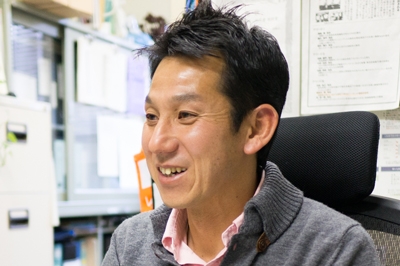
Associate Professor Hasegawa reminisces about his student years, when he became completely absorbed by research.
The 3-kans
Associate Professor Hasegawa attaches great importance to the 3-kans when teaching his students. The 3-kans are kanshin (interest), kando (being impressed), and kansha (gratitude), Why these three words?
“Students choose my research field or my lab because they’ve developed an interest in it. I’d like them to think in depth about the theme that they’re interested in and take responsibility for following it through right to the end. I’d also like them to repeatedly carry out experiments and verification until they reach the point of being impressed by how far they’ve come and how well they’ve done. Moreover, if they want to become professionals, they have to be able to impress other researchers when giving presentations at meetings of academic societies and the like. Then, when they’ve completed their research, presented their results, and have established their reputation to some extent, I’d also like to ensure that they understand that their success was not achieved alone; I want them to remember to feel gratitude toward their junior colleagues who helped with their research and their senior colleagues and peers who looked at their data and gave them advice. Furthermore, I want them to feel an ongoing sense of joy in the fact that they were able to generate results precisely because they were part of a team and that they have research partners both within Japan and overseas.”
Associate Professor Hasegawa says that he takes care not to nag the students too much, to ensure that they gain a true sense of these 3-kans. He says that if you respect individual opinions and actions and allow them to get on with their research, the students will come up with various ideas.
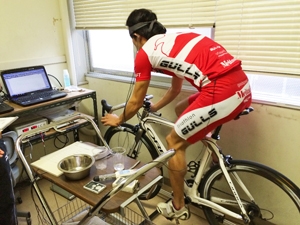
An experiment using a competitor from the Triathlon Club. It is verifying the effects of drinking a cold drink on cerebral blood flow regulation, body temperature, and exercise capacity.
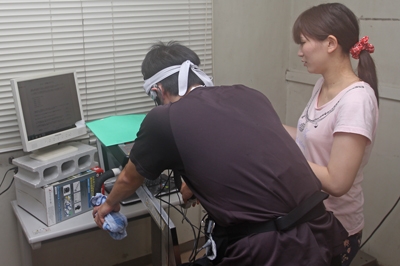
A student pedals an exercise bike to gather data concerning exercise.
Teamwork is the lifeblood of the research lab! Striving to create an enjoyable atmosphere.
Associate Professor Hasegawa says that he takes care to create a good atmosphere in his lab, so that students can freely conduct their research.
“Recently, I’ve been cycling at Onomichi and along the Shimanami Expressway with the members of my seminar group, and in October we held a party to welcome the new members of the group. My seminar group has lots of fun events. Nevertheless, I sometimes try to inspire my students by writing things like ‘Autumn is harvest time. It’s the season for getting your experiments underway in earnest.’ on the lab website. A research lab is just like a soccer team: teamwork is vital to enable both individuals and the lab as a whole to achieve results. Creating a good atmosphere is crucial to improving teamwork.”
There’s another reason why Associate Professor Hasegawa attaches such importance to creating a good atmosphere.
“Turning failure into success: that’s really important in research. When you’re young, adults and those around you will forgive your failures and create an environment in which you can try things out. That’s exactly why I want my students to try everything they can, without fearing failure. The next important thing is to make good use of those experiences of failure. You can’t create an environment like that unless there’s a good atmosphere in your lab. If you have the support of your peers, it’s easy to turn failure into success. It also becomes easier to try various things out and even if that challenge ends in failure, you can think, ‘Well, I’ll succeed next time.’ That applies to me too. In both basic and applied research, you can’t achieve results without the support of other researchers, students, research institutes, sports associations, and manufacturers,” he says emphatically.
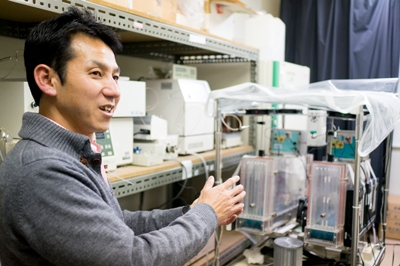
Associate Professor Hasegawa shows us around his laboratory.
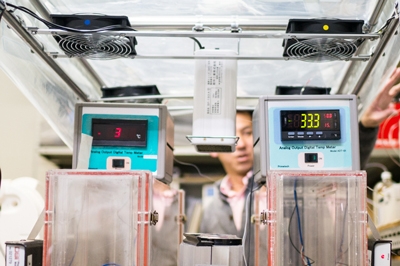
Gathering large amounts of data from rats concerning cerebral neurotransmitters and the thermoregulatory response
Considering strategies for adapting to global warming that are suited to Japan
In recent years, many people of all ages have been falling victim to heat stroke each summer. The rise in average air temperatures due to global warming is regarded as the likely culprit. If average air temperatures continue to rise in this way, the number of those suffering heat stroke will increase proportionately.
“To ensure that this doesn’t happen, I’m working on applied research to develop items that will be effective against the heat, while in my educational activities, I’m using lectures and extension courses to appeal for methods of creating bodies that can adapt to the heat. Through both research and education, I’d like to consider strategies for adapting to global warming that are suited to Japan, including measures focused on the 2020 Tokyo Olympics,” says Associate Professor Hasegawa, talking passionately of his future activities.
Finally, he had this enthusiastic message for those who are thinking about taking the entrance examination to become an undergraduate or graduate at Hiroshima University: “If you’re interested in the topics being researched in the field of exercise physiology and environmental physiology, come to Hiroshima University to study cutting-edge sports science and let’s think about practical ways of beating the heat.”
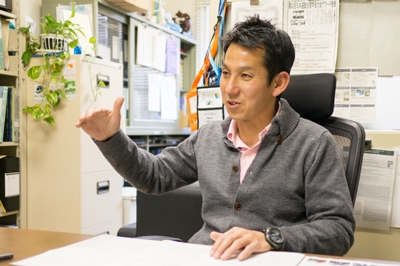
Associate Professor Hasegawa talks about the prospects for future research.
Afterword
About 70% of those taking Associate Professor Hasegawa’s extension course aimed at the general public are repeat participants. Each class features not only a lecture, but also practical exercises that give participants the chance to get their bodies moving. These practical exercises are the secret of his course’s popularity. Breaking a sweat like this not only feels good, but also helps to promote understanding of the course content. In addition, in his research and educational activities, he himself sweats it out with the test subjects as an observer gathering data during environments that replicate hot conditions. He says, “When I’ve gathered good test data, I think, ‘I’ve worked up a good sweat.’” I felt that it is this diligent attitude to education and research that is the key to the popularity of his extension course and the achievements of the students that he supervises. (N)


 Home
Home

